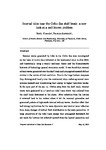Internal tides near the Celtic Sea shelf break: A new look at a well known problem
Date
2015-09Author
Subject
Metadata
Show full item recordAbstract
Internal waves generated by tides in the Celtic Sea were investigated on the basis of in situ data collected at the continental slope in July 2012, and theoretically using a weakly nonlinear theory and the Massachusetts Institute of Technology general circulation model. It was found that internal solitary waves generated over the shelf break and propagated seaward did not survive in the course of their evolution. Due to the large bottom steepness they disintegrated locally over the continental slope radiating several wave systems seaward and transforming their energy to higher baroclinic modes. In the open part of the sea, i.e. 120. km away from the shelf break, internal waves were generated by a baroclinic tidal beam which was radiated from the shelf break downward to the abyss. After reflection from the bottom it returned back to the surface where it hit the seasonal pycnocline and generated packets of high-mode internal solitary waves. Another effect that had strong implications for the wave dynamics was internal wave reflection from sharp changes of vertical fluid stratification in the main pycnocline. A large proportion of the tidal beam energy that propagated downward did not reach the bottom but reflected upward from the layered pycnocline and returned back to the surface seasonal pycnocline where it generated some extra higher mode internal wave systems, including internal wave breathers.
Collections
Publisher
Journal
Volume
Pagination
Recommended, similar items
The following license files are associated with this item:


